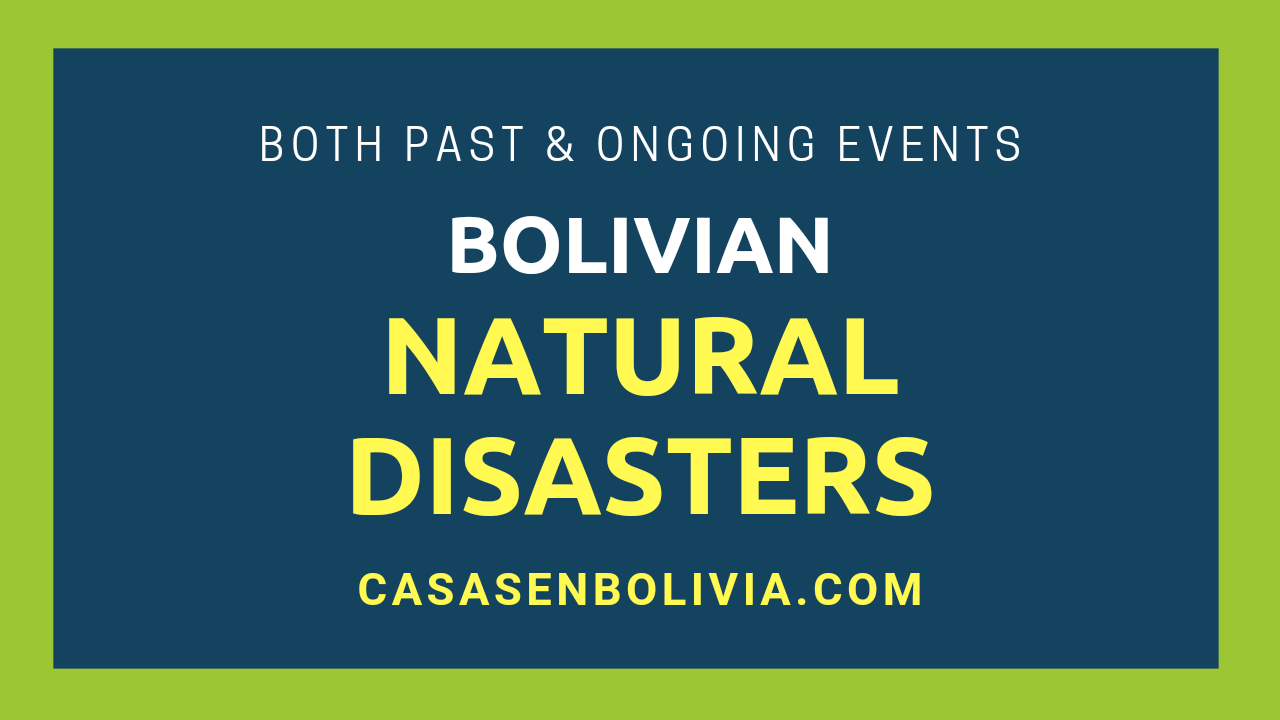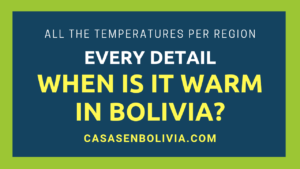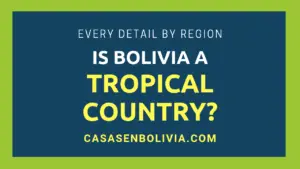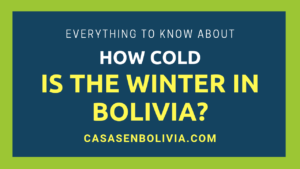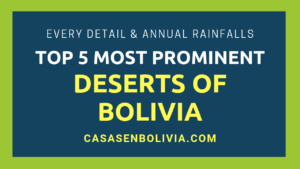Last Updated on February 15, 2025
Bolivia certainly experiences natural disasters, but generally, they are not as deadly as those in other parts of the world. Most disasters in the past have resulted in fewer than 100 fatalities, and the recurring natural disasters in the country typically don’t involve any deaths, although they still pose risks and require precautions.
The primary natural disasters that occur in Bolivia are: 1) major floods in large cities like Santa Cruz, Trinidad, and Cobija; 2) hailstorms in La Paz and Sucre; 3) extreme heat or cold in certain locations; and 4) droughts and wildfires in the Gran Chaco region. Other natural disasters are generally uncommon in Bolivia.
Here, we’ll discuss the most significant past and ongoing natural disasters in Bolivia. You’ll learn details, statistics, risks, and precautions related to these events. We’ll also highlight the five main natural disasters in the country. We are Bolivian real estate experts who have lived here our entire lives.
Natural Disasters in Bolivia Are Generally Not Severe
It’s very uncommon to see natural disasters that involve more than 100 fatalities in Bolivia. In other countries, events like tsunamis, cyclones, and earthquakes can claim thousands of lives. *However, Bolivia is generally a calm place, where extremely harmful events rarely occur.*
Warning: Health Hazards!
On the other hand, Bolivia has some significant endemic diseases. First is Chagas disease, which affects over 30% of the population in tropical areas. Dengue is also present every year in tropical cities, along with other illnesses like Zika, Yellow Fever, and Malaria.
Always be vigilant to avoid these diseases, particularly Chagas disease, which irreversibly damages the heart, and Dengue and Malaria, which can be fatal and are very difficult to treat.
What Natural Disasters Typically Occur in Bolivia?
In Bolivia, *most natural disasters involve major floods, hailstorms, and tropical rainstorms*. There are also some droughts and wildfires in certain regions. Additionally, extreme heat or cold can occur and, in some cases, lead to heat waves.
However, events like tornadoes, earthquakes, famines, volcanic eruptions, tsunamis, blizzards, and cyclones are very unlikely to occur in the country.
The following table presents the most significant ongoing and recurring natural disasters (those that occur annually), as well as several past disasters that have left a lasting impact on the Bolivian population.
| Recurring Natural Disasters | When It Happens | Precautions to Take |
| Major floods in tropical cities | October to February | Stay in an elevated area of the city |
| Heavy hailstorms in the Altiplano | November to April | Find an elevated, sheltered place for protection (*in Sucre City, they are still deadly*) |
| Tropical rainstorms in tropical cities | August to February | Find a well-sheltered area for cover |
| Extreme cold or heat in various locations | May to August | Wear appropriate clothing; learn more about these events (heat, cold) |
| Major droughts in the Gran Chaco | Suddenly, any time of year | Avoid getting lost there; no urban areas are nearby |
| Past Natural Disasters | Death Toll | Date of Event |
| Deadly hailstorm in La Paz | 74 people | February 19th, 2002 |
| Deadly hailstorm in Sucre | 4 people | January 4th, 2021 |
| Earthquake in Aiquile and Totora | 65 people | May 22nd, 1998 |
| Chacaltaya glaciers disappeared | – | September 2009 |
| Poopó Lake has almost dried out | – | August 2021 |
1) Major Floods in Tropical Cities
Bolivia’s largest cities often experience significant flooding *caused by heavy tropical rainstorms and river overflows*. Major cities like Santa Cruz de la Sierra, Trinidad, and Cobija, which together have a population of over 2 million, face this issue.
The areas in these cities that experience frequent flooding are:
- Many neighborhoods in Santa Cruz, mostly on the outskirts.
- Rural areas surrounding Trinidad city, sometimes also within the city itself.
- Throughout Cobija City, due to overflows of the Acre River.
All these cities are located in Bolivia’s tropical region, which has climatic characteristics very similar to the Amazon. Therefore, a significant amount of rainfall occurs there. These cities are also close to or surrounded by major, wide rivers, which occasionally overflow.
The floods that occur in these cities often affect lower-income populations (as wealthier individuals typically reside in areas of the city not reached by these floods), leaving them without homes and often requiring shelter. Floods usually occur during the country’s wet season, from September to April.
If you’re a tourist visiting these cities, you usually won’t need to worry about these events, *as hotels, tourist centers, and related establishments are generally located far from the areas affected by flooding*. However, if you experience a tropical rainstorm (which we’ll discuss later), take all necessary precautions.
2) Heavy Hailstorms in the Altiplano Region
In the western, colder part of the country, known as the Altiplano, it’s common to experience heavy hailstorms at the end of the year. *These storms can sometimes be deadly*, as has occurred in the past.
Past Deadly Hailstorms in La Paz City
For example, in La Paz City, one to five intense hailstorms occur every year, mostly between November and February. In the past, one of these storms in the city was so severe and catastrophic that it resulted in the deaths of 74 people. This event occurred on February 19, 2002.
This hailstorm was so intense that the city’s main streets suddenly transformed into powerful rivers, dragging people and cars into the city’s sewage system. In other streets, hail accumulation buried many unsuspecting individuals, even inside their homes.
Since that tragic event, the local government of La Paz *has made efforts to improve the city’s sewage system* to prepare it for similar storms in the future. And after that incident, *no other hailstorm has been deadly in the city*. However, these hailstorms haven’t diminished in intensity and remain dangerous.
Hailstorms in La Paz are usually quite intense and risky, and they tend to occur annually from November to February. When in this situation, *you must always seek a highly elevated, well-sheltered location to protect yourself*.
Still Deadly Storms in Sucre City
Not long ago, in 2021, a deadly hailstorm occurred in Sucre City, Bolivia’s former political capital. This disastrous event resulted in four deaths and numerous injuries.
This happened because this city, like La Paz, is not situated on flat terrain; it has a canyon-like form where water gains significant force as it flows down the roads. Therefore, the streets, due to the massive amount of fallen hail, *suddenly transform into powerful rivers*.
These sudden, powerful rivers on the streets begin to drag people into the drainage system or into areas where there is insufficient oxygen or air to breathe, compounded by the cold temperatures of the water at that moment. All these factors contribute to the fatalities when these hailstorms occur.
Hailstorms in Other Places in Bolivia
These heavy and even deadly hailstorms can occur in the following locations:
- La Paz City (deadly in the past)
- Northern Potosí (rural areas)
- Sucre City (still deadly)
- Tarija City
Other places in Bolivia, such as northern Potosí or Tarija City, can experience very heavy hailstorms at the end of the year, but these are generally not deadly or excessively risky. Nevertheless, you should always take all necessary precautions.
3) Tropical Rainstorms in Tropical Cities
Intense tropical rainstorms are very common at the end of the year, from August to February, in large cities like Santa Cruz, Trinidad, and Cobija. These are tropical, even Amazonian, urban areas that receive significant rainfall throughout the year.
These tropical rainstorms in the mentioned cities are characterized by:
- Long durations, with enormous amounts of constant rain.
- Winds exceeding 40 miles per hour (65 km/h) and the uprooting of large trees and even building structures.
- Lightning strikes that can be dangerous to people on the streets and can sometimes reach them (few cases are known).
- This massive rainfall can cause sudden flooding across the city.
When these rainstorms occur, it’s common to see large trees wobbling and even being uprooted. Parts and roofs of houses can also be lifted and blown away, becoming dangerous projectiles. Vehicle traffic becomes very chaotic, and all the surrounding streets begin to flood. Despite all this, *it’s unlikely for these events to cause fatalities*.
Whenever you find yourself in an intense rainstorm in Santa Cruz, Trinidad, or Cobija cities, and nearby urban areas, avoid open spaces (due to the risk of flying objects and lightning strikes) and move to a higher elevation within the city, in a sheltered location. If you’re on the outskirts, be aware that floods on streets may suddenly appear.
4) Extreme Cold or Heat in Some Cities at Certain Times of the Year
Bolivia is a country with many different climates. Some regions with extremely cold temperatures can trigger hypothermia, while other regions, with very high temperatures, can trigger heat waves.
Places That Get Very Cold
Cold weather is normal in the following places, but sometimes these very freezing temperatures can lead to various hazards.
The places that can experience very cold temperatures, reaching 15°F (-10°C) or lower at certain times of the year, are:
- The Andes mountain range, for alpinists and climbers.
- The Altiplano region and its cities, such as La Paz, El Alto, Oruro, and Potosí.
- The Uyuni Salt Flat, Red Lagoon, Eduardo Avaroa National Park, and nearby locations.
- The southwestern part of the Potosí department and its towns.
Heavy hailstorms can destroy large agricultural areas (as often happens every year in southwestern Potosí) or strike major cities, as we’ve shown previously. Freezing temperatures can also trigger hypothermia in homeless and intoxicated individuals in the mentioned locations.
We have a comprehensive guide about the coldest places in Bolivia, detailing temperatures, the coldest seasons, and necessary precautions, available here: The coldest places in Bolivia: A full overview.
Places That Get Very Hot
Almost 40% of Bolivian territory has a climate very similar to that of the Amazon, though slightly drier, where very high temperatures are common and can trigger some natural disasters.
The places that can experience very high temperatures, reaching 105°F (40°C) or higher at certain times of the year, are:
- Both rural and urban areas within the Gran Chaco region.
- Across the tropical eastern part of Bolivia, including large cities like Santa Cruz, Trinidad, and Cobija.
- Tourist destinations such as Madidi National Park, Rurrenabaque, Chiquitania, and surrounding areas.
Extremely high temperatures in all these locations can result in heat waves, droughts, and wildfires, as occurs in the Gran Chaco. They can also lead to rainstorms in large cities, as mentioned earlier, as well as major floods and similar situations. They can also trigger heatstroke in unaware individuals outdoors on a sunny day.
We have a detailed guide that provides all the information about the hottest places in Bolivia, their weather and temperatures, including all necessary precautions, available here: The hottest places in Bolivia: Everything you need to know.
5) Major Droughts and Wildfires in the Gran Chaco Region
The Gran Chaco is a tropical savanna in Bolivia where temperatures can be very high year-round, but even hotter from September to April. The extremely high temperatures, combined with a lack of rainfall, can lead to sudden droughts in this region. These droughts *can occur at any time of year and can last for extended periods*.
Furthermore, the lack of water and rainfall, coupled with the extremely high temperatures, often trigger extensive wildfires in this region. Very frequently, both droughts and wildfires in the Gran Chaco *necessitate government intervention and the provision of aid and support* in this area.
There are no large cities in the Gran Chaco; this is also not a tourist destination frequently visited by foreigners. However, some important towns are located there, such as Villa Montes, Yacuiba, Bermejo, and Palos Blancos. Whenever you are there, be cautious about getting lost *and also with the possibility of heatstroke*.
The Most Significant Past Natural Disasters in Bolivia
Some significant natural disasters have occurred in Bolivia’s past, which we’ll discuss in this section.
An Earthquake in Aiquile and Totora
Earthquakes are uncommon in Bolivia; there are no records of deadly earthquakes in any part of its territory. Most earthquakes range between 3 and 6 on the Richter scale, *but there is one exception*.
On May 22, 1998, one of the deadliest and most tragic disasters occurred in Bolivia: an earthquake in the towns of Aiquile and Totora and nearby areas, which killed approximately 75 people and injured another 74. Its magnitude was 6.8 on the Richter scale.
Because earthquakes are uncommon in Bolivia, the buildings and structures in that area and its towns were unprepared for this event. As a result, most of them were destroyed and collapsed on many residents. Since that terrible event, no other deadly earthquake has occurred in Bolivia in recent times.
A Deadly Flood in Downtown La Paz City
As we mentioned earlier, an unusually heavy hailstorm occurred on February 19, 2002, in La Paz city. It was so intense that the city’s main streets were transformed into powerful rivers within minutes, sweeping people away.
People also died from hypothermia, and even cars were dragged into the city’s poorly maintained sewage systems. This terrible incident prompted the local government to modify and improve all of La Paz’s sewage and drainage systems. In subsequent years, similar hailstorms occurred, *but they were not as harmful or deadly*, as the city was better prepared for them.
However, there remains a significant risk of another of these very intense hailstorms occurring at the end of the year, from November to February, *so always be cautious about this possibility*.
The Glaciers of Chacaltaya Mountain Disappeared
Another significant climatic disaster, triggered by global warming, also occurred on Chacaltaya Mountain, where, decades ago, the world’s highest ski resort was located, at 16,400 ft above sea level (5,000m).
But the glacier on that mountain finally disappeared in the spring of 2009, never to return, and the ski resort that operated there closed. This is another tangible proof of the effects of global warming. As scientists say, some other mountains in Bolivia, like Illimani and Huayna Potosí, are following the same path as Chacaltaya.
Nowadays, it’s possible to visit Chacaltaya Mountain; numerous tourist packages are available. However, you’ll find only bare ground with some ice, not a glacier or a place to ski. *Be careful with altitude sickness when visiting this location*.
Lake Poopó Has Almost Dried Out
There has been a constant battle between natural forces recently at this lake until it has finally almost dried out, primarily due to global warming. This lake was a large body of water not long ago and even had medium-sized boats navigating its waters. But since 2010, it has become unnavigable and has shrunk to a small puddle of water.
Lake Poopó is located in the Altiplano, very close to the Uyuni Salt Flat. Its size has decreased from 850 sq mi (2,200 km2) to three bodies of water of only about 0.39 sq mi (1 km2) each.
Other Significant Dangerous Events in Bolivia
As previously mentioned, endemic illnesses are very common in Bolivia, including:
- Chagas disease
- Dengue
- Malaria
- Yellow fever
- Zika
These are almost always present across most parts of the country. You should always take all precautions against these diseases!
Another situation worth mentioning is that roads and interdepartmental routes *often experience landslides* that delay the arrival of buses and other transportation.
Conclusions:
In this guide on Bolivia’s main natural disasters, you’ve seen that they can be categorized into five groups: 1) major floods in large tropical cities; 2) hailstorms in La Paz and Sucre, some of which have been deadly; 3) intense rainstorms in large tropical cities; 4) extreme heat or cold in certain locations; and 5) droughts and wildfires in the Gran Chaco region.
There have also been some significant, isolated natural disasters in the country’s past: 1) an earthquake in the towns of Aiquile and Totora that killed 74 people in 1998; 2) a deadly rainstorm in La Paz that killed 75 people in 2002 and another in Sucre that killed 4 people in 2021; 3) the disappearance of the Chacaltaya glaciers in 2009; and 4) Lake Poopó has almost dried out since 2015.
You’ve realized that in Bolivia, the worst natural disasters usually don’t involve the death of more than a few people. However, endemic diseases are incredibly harmful to the Bolivian population, and you should focus on this issue rather than on natural disasters when staying in Bolivia, avoiding illnesses like Chagas disease, Dengue, Malaria, and other significant health concerns.
We hope this information has been helpful. If you’d like to learn more about the climate in Bolivia, including more information on the coldest locations in the country, please visit our definitive guide here: How is the climate in Bolivia? A complete overview.
CasasenBolivia.com, information on living, working, investing, and traveling in Bolivia.

